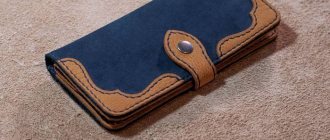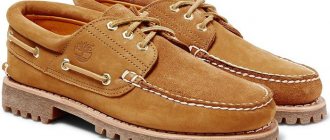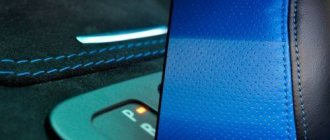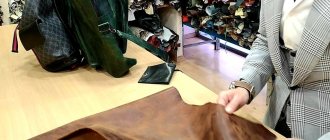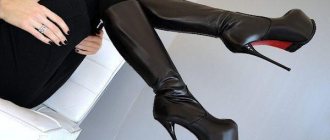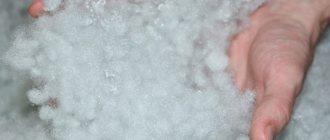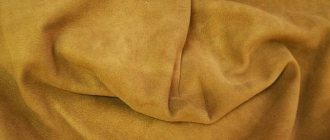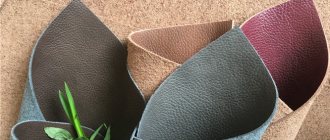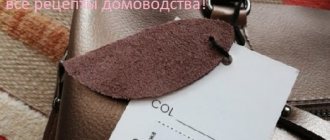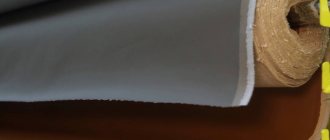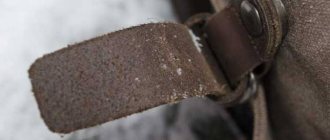Nubuck or leather – which is better?
To make high-quality shoes, many manufacturers use only natural materials that have been valued at all times.
The most common raw material is, of course, leather. More elite ones include suede and nubuck. Many people, out of ignorance, believe that nubuck is a type of artificial leather, so products made from it are more affordable. In fact, to obtain this raw material, the skin of a young animal undergoes a polishing process, which creates a soft and velvety texture.
What is better in winter - nubuck or leather?
Pigskin and calfskin are used much more often for the manufacture of shoes and various accessories. For supporters of traditional options, this raw material is considered an ideal option. However, if you compare all the pros and cons, then what is better, shoes made of nubuck or leather?
In winter, the warmest, waterproof and breathable products become preferred. Pros of standard leather include versatility, waterproofness, strength and durability. Although, with prolonged wear, deep creases appear, which are reflected in the appearance.
Natural nubuck is quite durable, soft and pliable, so with proper care it retains its attractive appearance for a long time and dries quickly. In addition, due to sanding, the material becomes more breathable than regular leather. Frost and snow are not scary for him, but rain and slush should be avoided.
There is also artificial nubuck, which is quite difficult to visually distinguish from natural, but the differences between them are significant. The polymer material is waterproof, but it also does not allow air to pass through, which is very bad for the health of the feet. Although in terms of durability and accessibility it occupies a leading position.
As you can see, each type of leather has its pros and cons. Therefore, when choosing shoes for the winter, you should listen to your feelings, which will help you decide on the ideal option.
Nubuck
This is one of the varieties of natural leather. Despite the fact that nubuck products are widely represented on the market, there are many false statements about it. For example, for some reason many people believe that this is one of the varieties of leatherette. In fact, this is genuine leather treated in a special way.
Important! The manufacturing technology is as follows. The leather is subjected to chrome tanning and then polished using abrasives: sand, sandpaper. The purpose of this treatment is to obtain a velvety surface that is very pleasant to the touch.
Another typical mistake: they often equate suede with nubuck. Although they have only one thing in common: they are based on the skin of various animals. To obtain nubuck, cattle leather is used, which determines its strength.
The scope of its application is quite diverse:
- Making footwear: boots, shoes, boots: for men, women and children.
- Bags, purses, accessories.
- Outerwear. Vests and jackets are quite durable and warm, although they are not as common as suede ones.
- Furniture production - as upholstery, as an alternative to leather and textiles.
Important! It is hardly correct to say that nubuck or suede is more practical, since each of them has its own area of application.
Advantages:
- Beautiful appearance.
- Vapor permeability (the material “breathes”).
- Reasonable price.
Important! To appreciate all the advantages of this material, you need to be able to determine the quality of products and care for them. As an example, here are useful tips regarding shoes, since they are the most popular in using such material:
- How to choose the right nubuck shoes?
- How to clean nubuck boots?
Flaws:
- Need for special care.
- Inability to wear in wet and dirty weather. Clothes and shoes can be hopelessly damaged.
- Less durable than regular leather.
Kinds
In addition to natural, there is artificial nubuck. Outwardly, it looks like natural material and is quite wear-resistant. However, the “breathing” effect in an artificial product is completely absent. Breathability is also lower than that of natural tanned leather. The cost of products made from artificial material is quite low.
In addition to natural and artificial nubuck, there is also a third variety - nubuck oil. This is a material impregnated with fat, which protects the product from getting wet.
Important! Nubuck oil shoes feel damp or a little greasy to the touch. As practice shows, this is an ideal option for demi-season shoes. Therefore, if you think what is better - suede or nubuck for this time of year, then the choice is obvious.
Leather, nubuck and suede: description
First of all, genuine leather, nubuck or suede are all types of leather. The difference between the two is actually very simple, depending on what part of the leather is used and how it has been treated. Nubuck is a type of leather that has been treated and polished.
Genuine Leather
Genuine leather is a type that has not been sanded. For example, raw cowhide is high quality leather. It is made from that part of the leather that is almost free of defects, that is, without cuts, tears or holes of any kind. That's why it doesn't need to be sanded.
Full grain leather is a type of leather that has not been processed at all and bears the original markings of the animal from which it came. The characteristics of the skin vary greatly depending on the type of animal. This is one of the most natural leathers.
Unsanded is one of the most processed and most popular leather options. Its top layer is polished and processed. This group of skins includes the most common types. These leathers are treated to make them more uniform and eliminate any imperfections that may have been found on the animal's hide.
Historically, nubuck was made from deer or elk leather and was introduced to the American market in the early 1930s. At first, this new skin type did not have much success until the Duke of Windsor went on a royal visit to the United States. He wore Oxford shoes made of the new nubuck, and thanks to him the new style became popular.
To make nubuck, an outer layer of calfskin is used, then the leather must be sanded on the outside. In most cases, nubuck is more expensive than suede. This is because the outer layer of calfskin is tougher than the inner layer used for suede and is therefore stronger and will last longer. They fall into the aniline leather group, although they are not one. Aniline leather makes up the smallest percentage of leather in the world. It may differ in a lighter color. However, there is a downside to this because nubuck is sanded on the outside and may have some of the natural imperfections of the leather.
Prices
Nubuck belongs to the premium class of upholstery and shoe materials. Its price is slightly lower than for suede, but higher than for our usual leather without surface treatment.
Natural material can be purchased in specialized stores at a price of 0.7 dollars per 1 square inch. Naturally, the price rises when animals such as yak and elk are taken for its production, and also subjected to fine processing of the front surface.
Synthetic or artificial nubuck for carpets, upholstery and other needs can cost $3-5 per square meter. Depending on the number of layers of polymers, their thickness and structure. Usually it goes in the “Fabrics” and “Artificial Leather” sections.
Nubuck is aesthetics and beauty. It is used to upholster Italian furniture, thanks to it the surfaces of armchairs and sofas become pleasant to the touch. Of course, there is a huge difference between natural and synthetic material.
Natural is more suitable for the bedroom. It cannot be cleaned and washed very often; it absorbs moisture and is afraid of strong mechanical influences. But its appearance evokes only pleasant thoughts; you immediately want to touch it, lie down on its surface. The tactile sensations when touching it are almost the same as when touching suede.
Artificial is more practical and common. It can be found in car showrooms, on the floors of children's rooms, in living rooms and kitchens. Its water-repellent properties allow this material to be washed and cleaned a considerable number of times.
Nubuck does not like moisture, so try to avoid it: do not wear nubuck shoes in rainy and slushy weather, do not walk in puddles in them. However, if you do get your nubuck shoes wet, regular shoe cleaning products used for leather will not work for you - they will destroy the nubuck. To care for nubuck shoes, special products and brushes have been developed that carefully remove dirt and preserve the texture of the material.
Before cleaning contaminated nubuck shoes, dry them thoroughly; you should not clean wet shoes. Take a special brush for nubuck and remove dirt from the top and sides of the shoe, and remove dirt from the heel and sole with a flannel cloth that can be slightly wetted. If whitish spots or streaks appear on your shoes, you can remove them with a damp cloth, then dry the shoes and continue cleaning. After cleaning with a sponge, apply a waterproof paint, then use a water-repellent spray.
If heavily soiled, more intensive care for nubuck shoes is required - washing. But this is not washing in the usual sense - such a procedure will make the skin ugly, brittle, and the shoes will become unusable. Nubuck shoes should be washed with ammonia diluted in water (a few drops per 3 liters) using a damp flannel cloth or microfiber sponge.
We suggest you read How to completely clean your computer
But even if the weather is dry outside, it is necessary to clean and treat nubuck with waterproof impregnation every day. If you see a speck of dirt on your nubuck boots, but you do not have the opportunity to properly clean them right now, then take a nail file and carefully remove the dirt with it.
Caring for nubuck shoes also includes proper storage: such shoes should be stored in loose boxes or bags that are well-permeable to air, after cleaning the shoes and applying protection.
What is the difference between nubuck and suede?
Nubuck is actually a type of suede, and both are typically made from leather such as calfskin, although they can also be made from sheep, cow, goat, or deer hide. At first glance, they look the same, but are actually created and processed differently, as noted earlier. Nubuck and suede differ from each other in that nubuck is created from the full-grain side of the hide, which is the outer part, while suede is created from the bottom part of the leather. Both of these leathers are created by sanding.
Because of this difference, there is a wide price range between nubuck and suede, with suede being the cheapest. Nubuck is made from the highest quality sanded leather used to make high quality leather products.
What is the difference between nubuck and suede:
- Nubuck has a velvety texture due to polishing, which creates a soft surface. Down are short protein fibers on the surface of the skin that help create a velvety surface.
- It is stronger and more durable, and more resistant to damage and wear than suede.
- It also has a genuine leather marking, giving it a rougher appearance than suede.
- Stronger and thicker than suede. It is usually more expensive than suede. For example, nubuck resists water damage because water simply darkens its surface temporarily and then dries without causing any long-term damage. Although its appearance is more similar to suede, nubuck has more similarities to aniline leather.
- Nubuck scratches easily. This is a vulnerable skin as it cannot use any type of protective coating.
- Suede is more flexible than nubuck. It's much more subtle.
- Suede is a good material for lining shoes, but it is not as durable as nubuck.
- It can also be painted easily because it has a more porous surface and it is recommended to apply a protectant to the surface.
When caring for suede or nubuck, it is important to choose the right brush for each material. Since nubuck is a harder material than suede, if a nubuck brush is used on suede, it will damage the down. On the other hand, a suede brush used on nubuck will be virtually ineffective.
Many people find that suede shoes are harder to maintain and more expensive than their shiny leather counterparts. This is far from the truth. Suede and nubuck actually require less maintenance. These boots don't need polishing and don't need to be polished at all, so say goodbye to weekly shoe polishing.
Nubuck or leather, which is better?
Initially, in the 1930s, the raw material for the production of nubuck was deer or elk leather. Modern manufacturing technology involves the use of an outer layer of calfskin, which is further processed through external grinding. Products made from nubuck are sold at a higher price than leather and suede. This is due to the fact that the outside surface of calfskin has a tougher texture compared to the inside used for making suede, which means the material is much stronger and more durable. This textile belongs to the aniline subgroup, but in fact it is not one. This is one of the rarest leather materials. It stands out with a much lighter shade.
Velor - textile or leather?
This fabric is produced, like nubuck, from cattle. Only the raw material also uses the skin of domestic artiodactyl. In terms of price characteristics: the cheapest both in production and sale.
Velor is sanded from the inside like velvet, and nubuck is sanded from the outside like suede. Velor has its advantages compared to nubuck and suede:
- Less capricious material in terms of care and processing.
- The pile is low and hard. Rarely clogs and is easier to clean.
- Inexpensive, accessible material when purchasing shoes.
- Casual clothes are made from velor. Suits are rarely made from suede. Nubuck is not suitable for this at all.
A good pair of shoes can be purchased for free. You don't have to choose high, shiny suede to walk down the street. Velor is not as afraid of water as nubuck. It is, of course, attractive and affordable, but when it comes to low maintenance, suede is an indispensable material.
Pros and cons of leather
Genuine leather is processed without sanding. To make the canvas, areas of leather are taken on the surface of which there are practically no defects in the form of tears, etc. Thanks to such high quality raw materials, there is no need for grinding. Full-grain fabric is not subjected to any processing, and is equipped with the original marking of the name of the animal from which it is made.
The properties of the skin directly depend on the type of animal. The unpolished type of material is further polished and treated with various compounds. For this, only the top layer is used. The finishing process is necessary to create a more uniform texture and correct any imperfections that might be present in the animal's hide.
The advantages of standard leather are: versatility of use, excellent water-repellent qualities, durability and long service life. One of the disadvantages is the appearance of deep creases with prolonged wear, which affect the aesthetics of the external appearance of the product.
What is better for winter, conclusion
It is worth paying attention to the fact that both types of materials retain heat well and look great. Nubuck can maintain its flawless appearance much longer. However, the leather does not allow water to pass through, and therefore can be used regardless of temperature conditions and type of precipitation.
What are the differences
The differences between the materials are presented in the table.
| Index | Leather | Nubuck |
| Tolerance to various mechanical influences | Well tolerated | Doesn't tolerate well |
| How quickly it wears out | Has a long service life | Not durable |
| Required care | Easy care | Needs special care |
| Ability to absorb water | Does not allow water to pass through | Water-permeable (cannot be worn in rainy weather) |
| Is the product shiny? | Not shiny | Shiny (especially with frequent wear) |
| How quickly it loses its presentable appearance | Maintains an aesthetic appearance for a long time | Quickly loses its aesthetic appearance |
| Can properties be changed using various means? | Possible, but not essential | You can significantly change the properties of the product |
| Air permeability | Does not allow air to pass through | Allows air to pass through |
| Price | High | Lower than leather products, but not significantly |
Which shoes are better for winter: leather or nubuck?
In winter, you want to look stylish and at the same time feel comfortable. Bad weather, frost, ice, and slush somewhat limit the choice of shoes. The catalog presents models made of genuine leather, nubuck, and velor. The assortment is large, so you can get confused. Let's figure out which is better: leather or nubuck.
Leather lovers strongly advise buying leather shoes. Fans of nubuck and suede took the other side. Any materials are suitable for winter. The main thing is to wear it correctly and take care of it. This article contains tips to help you choose the perfect pair. Let's figure out how nubuck differs from leather.
This is genuine leather that has undergone special processing. During dressing, it is tanned and polished. The result is a soft, finely fleecy surface. It resembles suede, but is made from different raw materials. Soft, pliable, but durable material ensures active air exchange. With proper care, it does not allow moisture to pass through and dries quickly. It looks elegant and presentable - these are advantages.
The material is afraid of water and slush - this can be considered a disadvantage. In such conditions, it quickly loses its attractive appearance. Nubuck differs from leather in price. The material is considered elite. Nubuck models are much more expensive than leather ones. We recommend these options for frosty snowy days. In slush, it is better to change into leather boots or shoes.
Rules for caring for nubuck shoes
Significant advantages of nubuck products are wear resistance and excellent tactile qualities. Disadvantages: the need to purchase shoe brushes for cleaning and use special cleaning compounds.
The first treatment of shoes is carried out immediately after purchase, before starting to wear them. Daily care consists of cleaning nubuck shoes with a soft brush or non-woven cloth and treating them with special dirt- and water-repellent agents: they will fight snow and dirt.
If you need to restore the color of your shoes, you will need special paint. It is applied using driving movements.
In order for nubuck shoes to last a long time, you need to follow 4 rules:
- do not leave wet dirty shoes overnight;
- do not wear in slush and rain;
- do not wash with wet rags;
- Do not use products with oil in their composition, as well as products for smooth skin.
Understanding what nubuck is, it will be possible to provide the material with high-quality care and significantly extend the service life of products. To find your ideal nubuck pair, visit shoe stores from the TAM.BY catalog.
Difficulties in care are the main reason for the unpopularity of this material. He is quite demanding in terms of means and methods.
To fully care for nubuck shoes you will need the following products and tools:
- Cleaning brush.
- Cleanser.
- Sponge for application.
- Eraser for removing light stains.
- Spray paint that is convenient for painting over scratches.
- Water-repellent impregnation.
- Deodorant is not a necessary product, but it will help remove unwanted odors. In addition, deodorants prevent staining of insoles and socks.
All this is sold both as a set and individually in shoe stores. Remember that they should be designed specifically for nubuck.
Cleaning Rules
To ensure that the material does not lose its properties, you need to know the rules for caring for it. Let's list the main ones:
- Shoes made of nubuck cannot be washed, washed, soaked, only wiped with a damp sponge.
- Dry, clean immediately after use, do not leave for another day.
- Cleaning is only possible on a dry surface.
- You need to clean it with a fine-bristled brush, do not rub or press too hard.
- Do not dry shoes near heating appliances, otherwise they will become hard and covered with creases and cracks.
- Be sure to cover with moisture-proofing agents.
- Do not use products for smooth skin that contain fats.
Cleaning procedure
You can successfully clean nubuck at home; you only need products suitable for this material. Traditional methods in such cases are powerless and will only harm the product.
Shoes made from nubuck should be cleaned in the following order:
- Remove large dirt: clods of dirt, stuck debris. If you can’t do this with a dry cloth, you should use a slightly damp sponge.
- Dry your shoes if they are wet by stuffing them with paper.
- Treat small stains with an eraser.
- Dirt or stains that could not be removed using the previous method must be cleaned with foam or shampoo.
- Dry the boots completely and treat them with impregnation spray.
Next, we will look at each stage in more detail.
Cleaning from dirt
First you need to wash the sole. This can be done under running water, but you need to make sure that the liquid does not get on the pile. It is best to wipe the product in a circular motion with a damp cloth; the fleecy surface can also be carefully cleaned in this way.
The second stage is cleaning with special means. You can clean nubuck using shampoo or shoe foam: apply a solution of one part of the selected substance in two parts of water to a napkin and gently wipe the pile. Then it should be dried and walked over the boots again with a dry brush.
We suggest you read: How to stretch nubuck shoes
Removing stains
A special eraser for this type of coating can easily remove small stains. Regular stationery will also work, but the effect will be worse.
If the stain is greasy, use a cleaner that degreases the surface (usually sold in spray form). After spraying, it should be left for 1-2 hours until completely dry. After this, the substance will turn into a kind of powder; it can be removed with a sponge soaked in a regular cleaner.
The most stubborn stains that cannot be washed with regular washing can be removed by sanding the product. This method should be used only as a last resort, since one careless movement can lead to damage to the boots. You need to take a sharpening stone and polish the shoes with it in the place where the stain appeared. After this, you need to go over the pile with a brush, removing traces of sanding.
The next stage of care is drying. It is necessary to dry your boots after each maintenance procedure, especially after cleaning them wet.
Shoes can be dried using a hairdryer. Directing a stream of warm air at the product, comb its pile with a brush. Drying material near heating appliances is prohibited, as the shoes will most likely become deformed.
Genuine Leather
Leather shoes are considered universal. Suitable for any outfit, for any weather. Do you think black or brown boots are boring? Thanks to the wide range of colors and variety of textures, it can offer interesting options for every day and “going out”.
The advantages of leather over nubuck are strength, durability, and water resistance. It is not afraid of slush, water, and dries quickly. Allows your feet to breathe. Maintenance will be required to maintain an aesthetic appearance. Use special creams, waxes, and impregnated sponges. The compositions protect the surface from cracking and creases, add shine, and repel moisture.
Any material has pros and cons. It’s impossible to say for sure which is warmer: nubuck or leather. The result depends on the internal insulation. If your feet get very cold in cold weather, choose shoes with natural or faux fur. Do you travel by car or are you rarely outside? We recommend looking at models insulated with fleece, fleece, and natural wool. They keep your feet warm and comfortable!
Secondary school (military scientist) Zernograd
The municipal budgetary educational institution secondary school (military science) of the city of Zernograd was founded on September 25, 1996.
The first building stone of the school was laid in October 1992 by a construction company (India) and already on September 25, 1996, the spacious, cozy, bright classrooms of the school were waiting for their first students.
At that time, the school was named, according to resolution No. 595 of the Zernograd district administration: Municipal secondary school No. 16.

